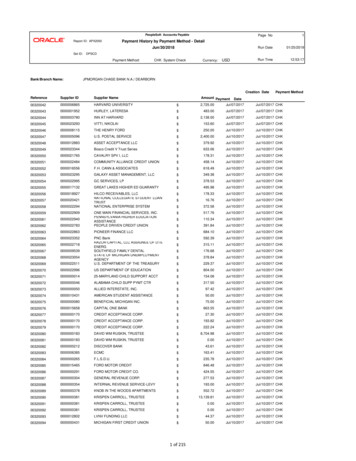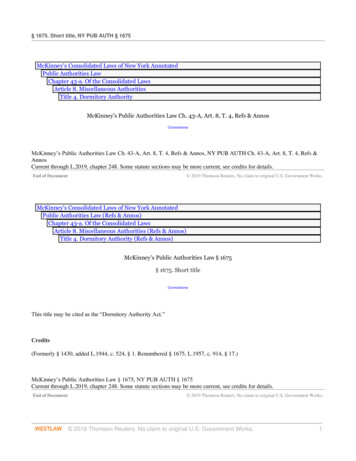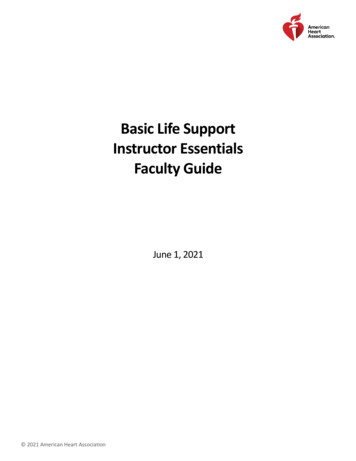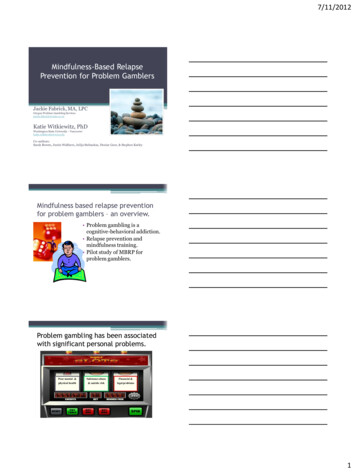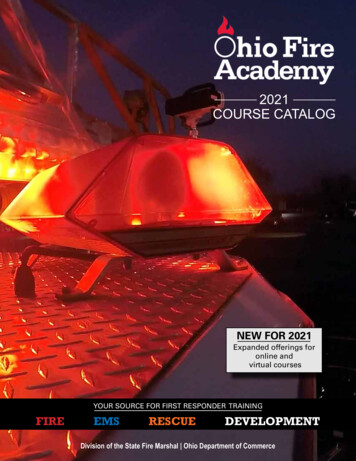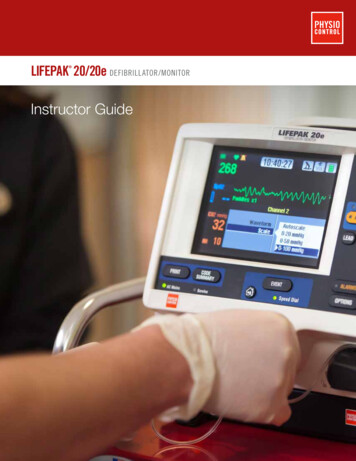
Transcription
LIFEPAK 20/20e DEfibrillator/MONITOr Instructor Guidea Instructor Guide for the LIFEPAK 20/20e Defibrillator/Monitor
How To Use This GuideThe LIFEPAK 20/20e defibrillator/monitor is easy to use and enables clinicians at everylevel to focus on the most important task at hand—saving a patient’s life. The 20/20e ishighly intuitive to use, and adapts to various patient environments. With this comprehensiveguide, you’ll be able to train your staff to effectively use the device.This instructor guide is an introduction to the basic operation of the 20/20e. It does notsuggest protocols or policies regarding the use of the defibrillator. Refer to OperatingInstructions for complete directions for use, indications, contraindications, warnings,precautions, and potential adverse events.This guide is designed for use with the factory default configuration of the 20/20e, whichis compliant with the 2010 American Heart Association Guidelines. It is important to befamiliar with the configuration of your particular defibrillator. Moving, removing, highlighting,and adding content to this outline to meet individual user needs is encouraged. Hands-onpractice and application with scenarios promote learning retention.Training TipsThis guide is divided into four sections:AED OperationManual OperationOptional FeaturesData Management and Other FunctionsThe AED mode is easy for healthcare professionals of all skill levels to quickly understandand use. This training course reviews the basic operation of the 20/20e in AED mode. Themanual mode operation is for the ALS providers and reviews the manual operation andfunctions of the 20/20e.The 20/20e retains data for two or more patients when you switch the power off or removethe batteries. The device automatically stores a CODE SUMMARY report as part of thepatient report for each patient. This section describes how to access this information andother functions associated with the 20/20e.All sections are optimally taught in a hands-on format. Instructors should first demonstratehow to use the defibrillator and then have students practice. Ideally, students will receiveenough practice and coaching from the instructor to ensure they can use the device withconfidence in an actual emergency.
AED Operation
AED Training CourseThe AED mode is highly intuitive and easy for healthcare professionals of all skill levels toquickly understand and use. This training course reviews the basic operation of the 20/20ein AED mode.Learning ObjectivesThe overall objective of this inservice is to provide an overview of the basic steps of operation of the identified controls, indicators, and connectors of the 20/20e. Upon completionof this course, participants will be able to: Verbalize the importance of early defibrillation. Locate and identify the defibrillator’s front panel controls, indicators and connectors. Demonstrate QUIK-COMBO electrode application. Demonstrate steps for automated external defibrillation (AED). Demonstrate the paper change. Demonstrate routine daily testing.Equipment and MaterialsThe following is a list of accessories and support material recommended for training on the20/20e. It is essential that all equipment be inspected and tested to ensure proper functionprior to training according to the Basic Orientation section of the Operating Instructions.Equipment LIFEPAK 20/20e defibrillator/monitorAccessories QUIK-COMBO therapy cable Test plug EDGE System electrodes with QUIK-COMBO connector (or clip-on trainingelectrodes) 3-lead or 12-lead patient simulator AC power cord 50 mm ECG printer paperSupport Materials Quick Reference Cards Student Study Guide Operating Instructions Performance EvaluationsLIFEPAK 20/20e Defibrillator/MonitorAED Training ClassThe following lists the content that should be covered during a typicalAED Operation Training Class. Early Defibrillation Biphasic Technology Controls and Features AED Operation Device MaintenanceInstructor Guide for the LIFEPAK 20/20e Defibrillator/Monitor 1
Early DefibrillationA New England Journal of Medicine study of 6,789 in-hospital cardiac arrest eventsdue to ventricular fibrillation or pulseless ventricular tachycardia reported 70% receiveddefibrillation in 2 or less minutes from recognition of Cardiac Arrest (CA). The survival rate(significantly) declined for the 30% of the patients who received defibrillation more than twominutes after cardiac arrest.1The American Heart Association (AHA) 2010 Guidelines for cardiopulmonary resuscitationrecommended defibrillation within 3 minutes of collapse in the hospital setting. More recently, the 2013 AHA strategies for improving in-hospital cardiac arrest call for defibrillationof any patient within 2 minutes of cardiac arrest. The AHA suggests hospitals deploy AEDsthroughout the hospital to achieve the target time and train staff to use the AEDs.AEDs can help your hospital staff improve their ability to deliver the first shock within therecommended 2-3 minute guidelines. The LIFEPAK 20/20e defibrillator/monitor can beused in AED mode to defibrillate without having to learn ECG interpretation. The AED issimple to use because it is designed to automatically analyze the patient’s heart rhythmand advise you which steps to take. In AED mode the device automatically selects theappropriate energy dosing.Biphasic EnergyHealth care providers may be confused about the right energy dose for biphasic waveforms because different defibrillator manufacturers recommend different energy dosingprotocols. It is important to clarify the correct recommended energy dose for biphasicwaveforms in order to avoid possible confusion that may result in a delay of therapy.ADAPTIV biphasic technology provides the option to escalate to 360J for best results.Studies show that refibrillation is common among ventricular fibrillation (VF) CA patientsand that defibrillation of recurring episodes of VF is increasingly difficult.2,3,4 LIFEPAKdevices give you the option to escalate your energy dosing up to 360J for difficult todefibrillate patients.Fortunately, all AEDs are programmed to follow a predefined energy dosing protocol. Inother words, the healthcare provider doesn’t have to worry about energy dosing. The AEDperforms this automatically.A biphasic waveform sends current one way at the start of the shock and then reverses itso the current flows in the opposite direction. A biphasic shock is a gentler but more effective shock. Physio-Control recommends a dosing protocol of 200-300-360 joules and isthe factory default setting in all LIFEPAK defibrillators. Physio-Control believes this energyprotocol can help minimize unnecessary CPR interruptions that result from ineffectivedefibrillation shocks.2 Instructor Guide for the LIFEPAK 20/20e Defibrillator/Monitor
Controls and FeaturesIn this section, the goal is to point out the different buttons and physical features pertinentto an AED user. Each of these features will be reviewed in greater detail later in this guide.Refer to the Operating Instructions for additional information.AED ButtonsThree buttons used for AED operation.1. ON2. ANALYZE(SHOCK)3.Speed DialScrolls through and selects menu items.Therapy Cable ConnectorConnects therapy cable to the deviceManual ButtonUsed to enter Manual Mode; pressing it opens the door and automatically takes the20/20e out of AED mode and puts it into Manual Mode. *Note: If the defibrillator isin AED mode and the door is open, or off, press ENERGY SELECT once to enterManual Mode. Full manual mode description is included in the Manual Mode TrainingCourse for ALS providers.Therapy Cable (Not Shown)The therapy cable is a defibrillation cable that attaches to therapy electrodes and to thetest plug. The 20/20e should be stored with the therapy cable plugged into the lower righthand side of the device.Instructor Guide for the LIFEPAK 20/20e Defibrillator/Monitor 3
AED Buttons1. ON2. ANALYZE3.(SHOCK)Manual ButtonSpeed Dial4 Instructor Guide for the LIFEPAK 20/20e Defibrillator/MonitorTherapy Cable Connector
Device MaintenanceMost hospitals have specific protocols for maintaining their defibrillators. Physio-Control provides a variety of tools designed to helpmanage inspection and maintenance procedures. Training for staff would depend on a hospital’s particular approach.BLS-trained responders should be familiar with several of the device maintenance procedures. How much detail you choose to go intowill depend on your hospital’s protocols.References to buttons are indicated in BOLD and display messages are indicated in ITALICS. For complete information, review theOperating Instructions for the device.TaskCheck defibrillator forDaily Auto Test results,if configured on.User action, defibrillator labels, text/voice prompts & information Ensure the defibrillator is plugged in. Ensure the therapy cable is plugged into the QUIK-COMBOtest plug.OR Ensure the standard paddles are clean, dry and properly seatedin the paddle wells and connected to the defibrillator.If the defibrillator detects a problem during the self-test it will remain“on” if connected to AC power and the SERVICE LED will illuminateand the printed report will indicate SELF TEST FAILED.If the defibrillator detects a problem while on battery power, theSERVICE LED will illuminate the next time it is turned on.Defibrillator should be checked daily following the auto test to confirm the test passed. If test failed or incomplete perform the manualuser test.TaskInspect the physical conditionof the defibrillator.User action, defibrillator labels, text/voice prompts & informationInspect Defibrillator for damage and foreign substances.TaskInspect power source.User action, defibrillator labels, text/voice prompts & informationConfirm that the AC Mains LED light is on the 20e and CodeManagement Module (if applicable).TaskCheck therapy andECG electrodes.User action, defibrillator labels, text/voice prompts & informationCheck QUIK-COMBO and EGG electrodes for “use by” date andthat a spare set is available.TaskExamine accessory cables.User action, defibrillator labels, text/voice prompts & informationInspect all cables including power cord for cracks, broken or bentparts and pins, and, if applicable, paddle surfaces for pitting.TaskDisconnect defibrillator fromAC power and wait 2 seconds.User action, defibrillator labels, text/voice prompts & informationDefibrillator turns on. If defibrillator doesn’t turn on, contact qualified service personnel. There should not be a Low battery connect to AC powermessage visible. If visible, it may mean the battery has reachedits end-of-life and needs replacing.Press ON.Look for SELF-TEST messageand illumination of LEDs.Instructor Guide for the LIFEPAK 20/20e Defibrillator/Monitor 5
TaskConfirm that the therapy cableis connected to defibrillatorand perform cable checks.User action, defibrillator labels, text/voice prompts & informationFor QUIK-COMBO cable:1. Confirm that test plug is connected.2. Press ANALYZE button. After ANALYZING NOW message,look for REMOVE TEST PLUG message.If CONNECT CABLE message appears, contact qualifiedservice personnel.Instructor activityDisconnect defibrillatorfrom electricity.For Standard Paddles:1. Confirm that paddles are properly seated in wells.2. Select 50J and press CHARGE button on paddles.(SHOCK) buttons on3. When fully charged presspaddles and look for ENERGY DELIVERED message.If CONNECT CABLE message appears, contact qualifiedservice personnel.TaskReconnect the defibrillator toAC power and turn device off.User action, defibrillator labels, text/voice prompts & informationConfirm AC MAINS LED is lit.TaskPerform Manual User Test.User action, defibrillator labels, text/voice prompts & informationThe manual user test should be performed if hospital protocol requires more frequent testing than the recommended daily auto test,or the daily auto test failed or did not complete, or if REDI-PAK electrodes are connected to the therapy cable.Press ON.Note: Ignore all REMOVETEST PLUG prompts andkeep the test plug connectedfor testing.For QUIK-COMBO pads: Confirm the QUIK-COMBOtherapy cable is connectedto the QUIK-COMBOtest plug. Press OPTIONS. Select USER TEST. Select YES to initiateuser test.For Hard Paddles: Confirm hard paddles cableis connected and paddlesare seated firmly in thepaddle wells. Repeat steps above underQUIK-COMBO pads.DiscussCleaningNote: If the defibrillator is in AED mode, switch to manual mode byopening the door or press the ENERGY SELECT button.Device will turn itself off after user test completed and print results.If the user test did not complete or self-tests failed, contact a qualified service personnel.User action, defibrillator labels, text/voice prompts & informationClean the LIFEPAK 20/20e defibrillator/monitor, cables and accessories with a damp sponge or cloth. Do not use bleach. Use onlythe agents listed below: Quarternary ammonium compounds Isopropyl alcohol Peracetic (peroxide) acid solutions6 Instructor Guide for the LIFEPAK 20/20e Defibrillator/MonitorInstructor activityConfirm Test Plug is connectedto QUIK-COMBO cable or thatstandard paddles are seatedfirmly in the paddle wells
AED OperationThe AED mode on the 20/20e is easy to use because it automatically analyzes the patient’s heart rhythm and advises you which steps totake. In AED mode the device automatically selects the appropriate energy dosing.References to buttons are indicated in BOLD and display messages are indicated in ITALICS. For complete information, review theOperating Instructions.TaskVerify the patient is incardiopulmonary arrest:unconscious/unresponsive,not breathing normally,and showing no signsof circulation.User action, defibrillator labels, text/voice prompts & informationNote the CONNECT ELECTRODES message and voice prompt occursuntil the patient is connected to the device:Press ON.TaskPrepare the patient fortherapy electrode placement.Connect therapy electrodesto the therapy cable, andconfirm cable connection tothe defibrillator.User action, defibrillator labels, text/voice prompts & information Bare patient’s chest. Remove excessive chest hair. Clean and dry skin. Abrade the skin briefly using a dry towel or gauze for betterelectrode adhesion to the skin. Do not use alcohol, tincture of benzoin, or antiperspirant toprepare the skin.TaskApply therapy electrodes topatient’s chest in anteriorlateral position.TaskPress ANALYZE button toinitiate analysis. Stop CPR.Instructor activityConnect therapy cable tothe rhythm simulator and setrhythm to VFInstructor activityConfirm correct placementUser action, defibrillator labels, text/voice prompts & informationYou will see and hear the PUSH ANALYZE message. Stop all motion including CPR. Do not move the 20/20e while analyzing. Clear everyone away from patient.Instructor Guide for the LIFEPAK 20/20e Defibrillator/Monitor 7
TaskConfirm everyone is clear.(Shock) button toPressdischarge AED.User action, defibrillator labels, text/voice prompts & informationYou will see and hear ANALYZING NOW STAND CLEAR, The AEDanalyzes the patient’s ECG and advises either SHOCK ADVISED orNO SHOCK ADVISED. If the AED detects a shockable rhythm, youwill see and hear SHOCK ADVISED.1. State “All Clear” and observe that all personnel are clear ofthe patient and immediate area.(SHOCK) button to discharge AED.2. Pressis pressed, you will see Energy Delivered messageWhen theindicating energy transfer was completed.Note: When energy transfer is complete, the shock counter increases by 1. This will continue to increase incrementally with everyenergy transfer.TaskSTART CPR.User action, defibrillator labels, text/voice prompts & informationSTART CPR screen message will appear. A CPR timer will countdown 2 minutes or CPR time duration.A metronome automatically provides 30:2 audible compression“tocks” and ventilation prompts.DiscussThe CPR metronome.The CPR metronome provides audible “tocks” that guide the user todeliver CPR with proper timing.In AED Mode, the default C:V ratio is Adult – no airway because mostpatients in cardiac arrest are adults who have an initially unsecuredairway. The CPR metronome can not be turned off in AED Mode.TaskStop CPR andpush ANALYZE.User action, defibrillator labels, text/voice prompts & informationWhen the CPR countdown time ends, you will see and hearPUSH ANALYZE.This message stays on the screen and the voice prompt will repeatevery 20 seconds until the ANALYZE button is pressed.TaskConfirm everyone is clear.User action, defibrillator labels, text/voice prompts & informationIf the AED detects a nonshockable rhythm, you will see and hear NOSHOCK ADVISED.TaskSTART CPR.User action, defibrillator labels, text/voice prompts & informationStart CPR per voice prompt and screen message. A CPR timer will countdown 2 minutes. Continue to follow screen messages and voice prompts until thecode team arrives.8 Instructor Guide for the LIFEPAK 20/20e Defibrillator/MonitorInstructor activityPlace rhythm simulator innon-shockable rhythm
DiscussTroubleshooting messages.User action, defibrillator labels, text/voice prompts & informationCONNECT ELECTRODES message and voice prompt occur If therapy electrodes are not connected to the therapy cable.Or If therapy electrodes are not placed on the patient’s chest.CONNECT CABLE message occursIf the therapy cable is not connected to the defibrillator. REMOVE TEST PLUG message and voice prompt occurs If the test plug is connected to the therapy cable when analysis isinitiated. Remove test plug and connect therapy electrodes to thetherapy cable.MOTION DETECTED, STOP MOTION message occurs If motion is detected during the ECG analysis, you will seeand hear MOTION DETECTED, STOP MOTION, followed by awarning tone. Analysis is inhibited up to 10 seconds. After 10seconds, even if motion is still present, the analysis proceedsto completion. TaskSwitching from AED toManual Mode.Switching from Manual Modeto AED mode.User action, defibrillator labels, text/voice prompts & information Enter manual mode by pressing the MANUAL button located inthe lower left corner of the door and opening door.Or If there is no door, or the door is open, press ENERGY SELECTbutton once to switch to manual mode. Instructor activityHave students switch devicebetween AED and manualmode and back to AED mode ressing ANALYZE while the device is in manual mode will returnPdevice to AED mode.Instructor Guide for the LIFEPAK 20/20e Defibrillator/Monitor 9
Manual Operation
Manual Training CourseThe manual mode training course is intended for the ALS-trained code team and reviewsthe manual operation and functions of the LIFEPAK 20/20e defibrillator/monitor. The20/20e automatically converts to a manual defibrillator simply by opening a door andtransitions easily to full therapy and monitoring capabilities. This training course reviews allof the advanced cardiovascular life support tools available in the 20/20e.Learning ObjectivesThe overall objective of the in-service is to provide an overview of the basic steps of operation of the identified controls, indicators, and connectors of the 20/20e. Upon completionof this course, participants will be able to: Verbalize the importance of early defibrillation. Locate and identify the defibrillator’s front panel controls, indicators and connectors. Demonstrate QUIK-COMBO electrode application. Demonstrate steps for manual defibrillation. State the procedure for synchronized cardioversion. List the operational steps for noninvasive pacing. Demonstrate ECG, pulse oximetry, and EtCO2 monitoring (if applicable). Describe the print process, transmitting, and recalling the code summary. Explain the power sources. Demonstrate routine daily testing.Equipment and MaterialsThe following is a list of accessories and support material recommended for ACLS trainingon the 20/20e. It is essential that all equipment be inspected and tested to ensure properfunction prior to training.Equipment LIFEPAK 20/20e defibrillator/monitor with Code Management Module (if applicable).Accessories QUIK-COMBO therapy cable Test plug EDGE System electrodes with QUIK-COMBO connector(or clip-on training electrodes) 3-lead or 12-lead patient simulator 3-wire or 5-wire ECG cable LIFEPAK 20/20e defibrillator/monitor standard adult detachable hard paddles(if applicable) SpO2 sensors (if applicable) EtCO2 cannula and T-piece connector AC power cord 50 mm ECG printer paperSupport Materials Quick Reference Cards Student Study Guide Operating Instructions Performance EvaluationsInstructor Guide for the LIFEPAK 20/20e Defibrillator/Monitor 11
LIFEPAK 20/20e Defibrillator/MonitorManual User Training ClassThe following lists the content that should be covered during a typical Manual UserTraining Class. Early Defibrillation Biphasic Energy Controls and Features Manual Defibrillation Synchronized Cardioversion Procedure Noninvasive Pacing ECG Monitoring Pulse Oximetry (if applicable) EtCO2 Monitoring (if applicable) Data Management Device Maintenance Other FunctionsEarly DefibrillationA New England Journal of Medicine study of 6,789 cardiac arrest patients reported 70%received defibrillation within 2 minutes. The survival rate declined for 30% of the patientswho received defibrillation more than two minutes after their cardiac arrest.1The American Heart Association (AHA) 2010 Guidelines for cardiopulmonary resuscitationrecommended defibrillation within 3 minutes of collapse in the hospital setting. More recently, the 2013 AHA strategies for improving in-hospital cardiac arrest call for defibrillationof any patient within 2 minutes of cardiac arrest. The AHA suggests hospitals deploy AEDsthroughout the hospital to achieve the target time and train staff to use the AEDs.AEDs can help your hospital staff improve their ability to deliver the first shock within therecommended 2-3 minute guidelines. The LIFEPAK 20/20e defibrillator/monitor can beused in AED mode to defibrillate without having to learn ECG interpretation. The AED issimple to use because it is designed to automatically analyze the patient’s heart rhythmand advise you which steps to take. In AED mode the device automatically selects theappropriate energy dosing.Biphasic EnergyHealth care providers may be confused about the right energy dose for biphasic waveforms because different defibrillator manufacturers recommend different energy dosing protocols. It is important to clarify the correct recommended energy dose for biphasic waveforms in order to avoid possible confusion that may result in a delay of therapy. ADAPTIVbiphasic technology provides the option to escalate to 360J for best results. Studies showthat refibrillation is common among ventricular fibrillation (VF) CA patients and that defibrillation of recurring episodes of VF is increasingly difficult.2,3,4 LIFEPAK devices give you theoption to escalate your energy dosing up to 360J for difficult to defibrillate patients.Fortunately, all AEDs are programmed to follow a predefined energy dosing protocol. Inother words, the healthcare provider doesn’t have to worry about energy dosing. The AEDperforms this automatically.A biphasic waveform sends current one way at the start of the shock and then reverses it sothe current flows in the opposite direction. A biphasic shock is a gentler but more effectiveshock. Physio-Control recommends a dosing protocol of 200-300-360 joules and is the factorydefault setting in all LIFEPAK defibrillators. Physio-Control believes this energy protocol canhelp minimize unnecessary CPR interruptions that result from ineffective defibrillation shocks.12 Instructor Guide for the LIFEPAK 20/20e Defibrillator/Monitor
Controls and FeaturesIn this section, the goal is to point out the different buttons and physical features pertinent to an ALS user. Each of these features will bereviewed in greater detail in latter sections of this guide. For complete information, review the Operating Instructions for the device.Area 1Area 7Area 2Area 5Area 3Area 4Area 6Instructor Guide for the LIFEPAK 20/20e Defibrillator/Monitor 13
Controls and Features ContinuedArea 1Buttons ON ENERGY SELECT CHARGE(SHOCK) SYNC ANALYZELED Light for AED ModeONSwitches power on or off.ENERGY SELECTSelects energy levels in manual mode.CHARGECharges the defibrillator in manual mode.SHOCKDischarges defibrillator energy to the patient.SYNCActivates synchronized mode.ANALYZEActivates Shock Advisory System (SAS).AED MODELED illuminates when AED mode is active.14 Instructor Guide for the LIFEPAK 20/20e Defibrillator/Monitor
Area 2Buttons PACER RATE CURRENT PAUSEPACERActivates the pacing function.RATESelects pacing rate.CURRENTAdjusts pacing current.PAUSETemporarily slows pacing rate.Instructor Guide for the LIFEPAK 20/20e Defibrillator/Monitor 15
Controls and Features ContinuedArea 3Buttons EVENT LEAD SIZE ALARMS OPTIONS(HOME SCREEN) LED Light for Speed DialSIZEChanges ECG size.LEADChanges ECG lead.EVENTActivates user-defined events.ALARMSActivates and silencesalarms.OPTIONSAccesses optional functions.LEDIlluminates when the Speed Dialis active.HOME SCREENReturns immediately to Home Screen.CONTRASTAdjusts screen contrast.16 Instructor Guide for the LIFEPAK 20/20e Defibrillator/Monitor
Area 4 ECG Cable ConnectorSpO2 Cable Connector (if applicable)Therapy Cable ConnectorSpeed DialIrDA PortSpeakerECG Cable ReceptacleSpeed DialScrolls through and selects menu items.LED illuminates when Speed Dial is active.SpO2 Cable ReceptacleIrDA PortTherapy Cable ReceptacleSpeakerInstructor Guide for the LIFEPAK 20/20e Defibrillator/Monitor 17
Controls and Features ContinuedArea 5 PRINTCODE SUMMARYLED Light for AC Mains and ServiceCODE SUMMARYPrints a CODE SUMMARY critical event record.ServiceIndicates that service is required.PRINTStarts or stops the printer.AC MainsLED illuminates when AC power (line power) is connectedand providing power.18 Instructor Guide for the LIFEPAK 20/20e Defibrillator/Monitor
Area 6 POWER INDICATORLED illuminates whenAC power (line power)is connected andproviding power.Power IndicatorCO2 PortCO2 PortInstructor Guide for the LIFEPAK 20/20e Defibrillator/Monitor 19
Controls and Features ContinuedArea 7Monitoring AreaWaveform Channel Area Status Message Area Monitoring AreaDisplays heart rate, time, SpO2, battery status indicator,indicators for VF/VT alarm and selected energy.Channel 1WaveformChannel AreaDisplays up to twowaveform channels.Channel 2Status Message AreaDisplays status and alarm messages.20 Instructor Guide for the LIFEPAK 20/20e Defibrillator/Monitor
Additional Areas Not ShownDoor with Manual access button (if applicable)Left Side PrinterTo load the paper:1. Press the black button to open the printer door.2. Remove the empty paper roll.3. Insert the new paper roll, grid facing upward.4. Pull out a short length of paper.5. Push the printer door in to close.32415Back view with the CodeManagement Module AC power cord connection ECG/SYNC connectorECG/SYNC ConnectorAC Power Cord ConnectionInstructor Guide for the LIFEPAK 20/20e Defibrillator/Monitor 21
Device MaintenanceMost hospitals have specific protocols for maintaining their defibrillators. Physio-Control provides a variety of tools designed to helpmanage inspection and maintenance procedures. Training for staff would depend on a hospital’s particular approach.BLS-trained responders should be familiar with several of the device maintenance procedures. How much detail you choose to go intowill depend on your hospital’s protocols.References to buttons are indicated in BOLD and display messages are indicated in ITALICS. For complete information, review theOperating Instructions for the device.TaskCheck defibrillator forDaily Auto Test results,if configured on.User action, defibrillator labels, text/voice prompts & information Ensure the defibrillator is plugged in. Ensure the therapy cable is plugged into the QUIK-COMBOtest plug.OR Ensure the standard paddles are clean, dry and properly seatedin the paddle wells and connected to the defibrillator.If the defibrillator detects a problem during the self-test it will remain“on” if connected to AC power and the SERVICE LED will illuminateand the printed report will indicate SELF TEST FAILED.If the defibrillator detects a problem while on battery power, theSERVICE LED will illuminate the next time it is turned on.Defibrillator should be checked daily following the auto test to confirm the test passed. If test failed or incomplete perform the manualuser test.TaskInspect the physical conditionof the defibrillator.User action, defibrillator labels, text/voice prompts & informationInspect Defibrillator for damage and foreign substances.TaskInspect Power Source.User action, defibrillator labels, text/voice prompts & informationConfirm that the AC Mains LED light is on the 20e and CodeManagement Module (if applicable).TaskCheck therapy andECG electrodes.User action, defibrillator labels, text/voice prompts & informationCheck QUIK-COMBO and EGG electrodes for “use by” date andthat a spare set is available.TaskExamine accessory cables.User action, defibrillator labels, text/voice prompts & informationInspect all cables including power cord for cracks, broken or bentparts and pins, and, if applicable, paddle surfaces for pitting.TaskDisconnect defibrillator fromAC power and wait 2 seconds.User action, defibrillator labels, text/voice prompts & informationDefibrillator turns on. If defibrillator doesn’t turn on, contact qualified service personnel. There should not be a Low battery connect to AC powermessage visible. If visible, it may mean the battery has reachedits end-of-life and needs replacing.Press ON.Look for SELF-TEST messageand illumination of LEDs.22 Instructor Guide for the LIFEPAK 20/20e Defibrillator/Monitor p
and use. This training course reviews the basic operation of the 20/20e in AED mode. The manual mode operation is for the ALS providers and reviews the manual operation and functions of the 20/20e. The 20/20e retains data for two or more patients when you switc

